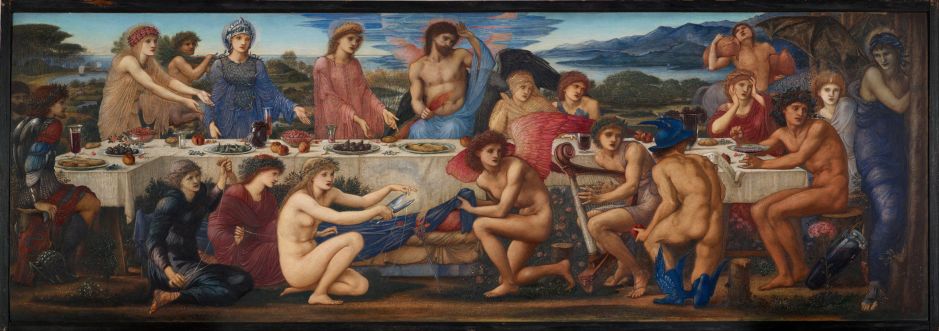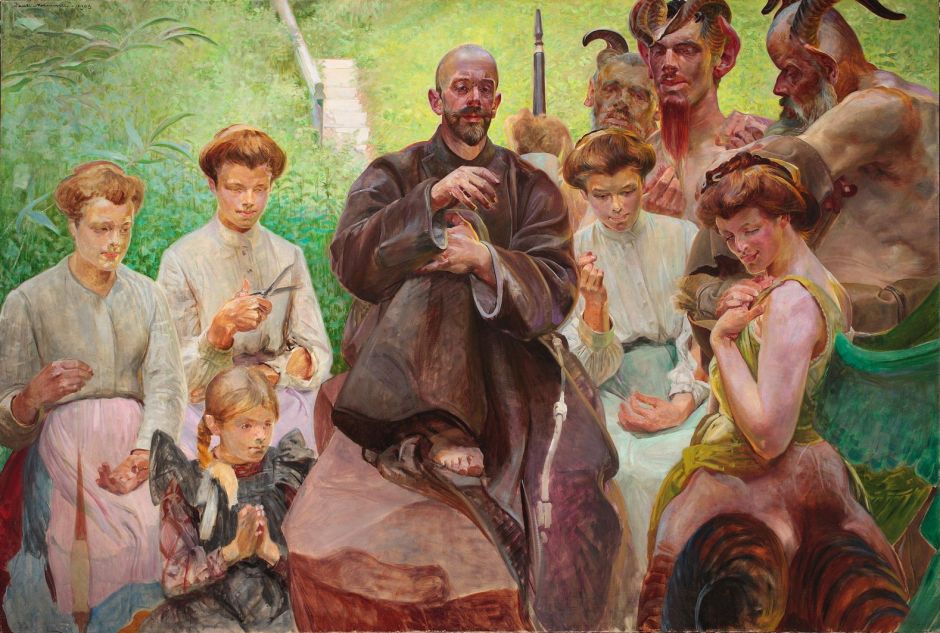Time is one of the two fundamental elements of narrative, the other being events. Depicting time is one of the great challenges in narrative painting, and referring to time as a concept within a visual story is even harder. This contrasts with verbal narrative, which has rich and precise tools such as the tense of verbs, which in some languages can succinctly pin down exactly when, how long for, and how often something happened, without the need for any reference to exact dates and times, or external information.
This weekend I look at some paintings which express time as a concept; this article looks at its representation in the hands of the Fates, and tomorrow I’ll look at metaphorical expression as a material thread.
In classical Greek and Roman mythology, the lives of humans are determined by the thread spun for them by the Moirai (Greek) or Fatae (Roman). Because of their importance, the Romans also came to refer to them euphemistically as the Parcae (the sparing ones). The three were further identified as:
- Clotho or Nona, the spinner, who holds a distaff and spindle to spin the thread of life;
- Lachesis or Decima, the allotter, who measures the thread allotted to each person using her measuring rod;
- Atropos or Morta, the unturnable, who cuts the thread for each person, choosing the time and manner of their death.

Il Sodoma’s classical depiction of The Three Fates from about 1525 shows, from the left, Lachesis, Atropos wielding her shears, and Clotho with her distaff and spindle. This painting may have been influenced by the contemporary publication of Ariosto’s Orlando Furioso (1512-1532), in which cantos 34-35 describe St John taking Astolfo to meet the Fates.

Rubens’ painting of The Fates Spinning Marie’s Destiny (1622-5) is the first in the series of twenty-four which were commissioned in 1621 to decorate the Luxembourg Palace, Paris, for Marie de’ Medici, who was the wife of King Henry IV of France.
He shows the three Fates without a pair of shears, suggesting the Queen’s relative immortality. Above them are Juno and Jupiter; Juno appears throughout the series at the Queen’s avatar, and Jupiter as the King. Given Jupiter’s promiscuity, this may have indicated deep insight into the royal relationship. Prior to their marriage in 1600, Henry had three children by his mistress Gabrielle d’Estrées, who had recently died in childbirth.

In this painting from about 1665, Pieter Thijs shows an even more significant group, with the Fates before Father Time. From the left, the Fates are Clotho and Lachesis, who are working together, and Atropos, with her shears, who is disarmingly looking straight at the viewer, knowing your fate.

One of Goya’s Black Paintings on the walls of his retirement villa on the outskirts of Madrid is thought to show Atropos, or the Fates. Here are Lachesis, the spinner of the thread of life, Clotho, with a distaff of a doll, and Atropos, with her shears to cut the thread and bring death. The fourth figure is not readily identifiable, and there has been much speculation as to its identity and meaning.

Edward Burne-Jones’ painting of The Feast of Peleus from 1872-81 uses a composition based on classical representations of the Last Supper. Every head has turned towards Eris (Discord) as she brings her golden apple, apart from that of the centaur behind her right wing. Even the three Fates, in the left foreground, have for once paused momentarily in their work.

This Salon-style depiction of the Fates by Paul Thumann from about 1880 became extremely popular throughout Europe, and was often reproduced on mass-produced porcelain. It is unusual for drawing such marked distinctions between the women: Atropos, on the left, is shown as a morose older woman, armed with her shears; Clotho stands to weave, and is young, very pretty, and bare down to the waist; Lachesis is modestly dressed and holding sprigs of vegetation, at the right.

This remarkable painting by John Melhuish Strudwick, a pupil of Burne-Jones of the Pre-Raphaelite Brotherhood, has an unusual depiction of the Fates in its bottom panel. Clotho and Lachesis are at the front, working together to spin and measure out the thread, which is here a mixture of gold (for life) and grey (see detail below). Atropos sits behind, poised to use her shears when ready. I am not sure of the origin of the two different coloured threads, which may be original to this artist.
Above the Fates, a young couple are courting, time being marked by the tolling of the bell in the tower. At the top, Love’s chariot awaits them.


Jacek Malczewski modernises the Fates in his fascinating allegorical portrait of St Francis of Assisi. All three appear similar, with similar clothing, hair, and features. Clotho is at the left, with a pink apron, Atropos holds a modern pair of scissors rather than the traditional shears, and has a light purple apron, and Lachesis is on the other side of St Francis, with a pale blue apron. The right of the painting contains a group of semi-human mythical creatures, rather than the traditional birds and small animals typically associated with this saint.

